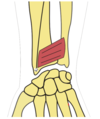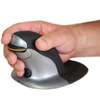Musculoskeletal disorders related to the use of a mouse
More and more ergonomic mice are appearing in the high-tech sector. These computer mice are very successful in the workplace.
Musculoskeletal disorders or MSDs are caused by the desire to be more productive. This increases the workload and stress. MSDs affect different parts of the body depending on the form in which they occur. Here, we will talk about MSDs caused by our old computer mice.
When we click with the mouse or when we want to pick it up, the forearm is forced to make a pronation movement, that is to say that the palm of the hand is towards the table as shown in the diagram below.

By carrying out this movement, several muscles of the forearm are then solicited. They are in particular the Brachium Radial, the Pronator Square and the Pronator Round.



As a result, as soon as we pronate or try to take something in our hands, these different muscles automatically contract. This can become problematic if we spend several hours behind the computer, involving intense use of the mouse. You will also notice that your arms also pronate when you use the keyboard of your computer and there is no solution, you are forced to be able to write on a keyboard. But it is therefore recommended to limit this movement, hence the appearance of the ergonomic mouse!
This accessory, which allows you to access your data more easily, was developed based on the biomechanical properties of the body. It is as effective as a standard mouse but with a difference in the position of the forearm. The forearm no longer pronates but remains in a neutral position. The various muscles mentioned above are no longer used. As a result, the risk of developing RSI is considerably reduced.

Different techniques to alleviate MSD pain:
Move your wrists: It is always recommended not to adopt a static position. You should be moving all the time. You probably remember the warm-up sessions during PE classes. You had to rotate your wrists. Repeat this same exercise to mobilize your wrists. This promotes blood flow to help lymphatic drainage and eliminate toxins.

Strengthen your muscles: it is important to strengthen your muscles because they have a stabilizing role on the joints. Frequent "weight training" helps to limit musculoskeletal disorders. There is a very simple exercise: the anti-stress ball. Squeezing a ball in the hand a little but regularly allows to strengthen the muscles of the hand but also those of the forearm, then do not hesitate any more.

Stay hydrated by drinking water: After working on the computer for a few hours, think of your muscles as a sponge full of dirt. To clean a sponge, you need to wash it with water and then squeeze it. Therefore, you need to drink a lot of water and move your wrists. It is also possible to massage the forearm and wrist.

Massage: To perform a massage on the wrists, it is not even necessary to go to an institute or to use a specific oil. You just need to perform a few simple gestures. Press on the areas that are hurting you on the forearm, wrist and hand and perform small circular massages. You can apply this technique at any time and anywhere you are. Of course, doing it by a professional is even better but on a daily basis do it alone.

Osteopathy: Sometimes, despite all our efforts, we cannot reduce the pain. On the contrary, they sometimes get worse or come back after a few moments of respite. This means that muscle fatigue is not the only cause of MSDs.
There are other factors that cause tension and imbalance in the body. Despite all your good will to implement the different techniques, you will need a consultation with an osteopath. The latter will establish a diagnosis of your health condition in order to recommend adequate treatments but also aims to remove all osteoarticular causes likely to generate a blockage, an inflammation of your wrist, forearm or the rest of your body.
Use physiotherapy: When you have been suffering for a long time, in addition to osteopathy, a physiotherapist can be useful. The latter will perform muscular work and deep massage on the painful area to improve the drainage of the inflammation.
